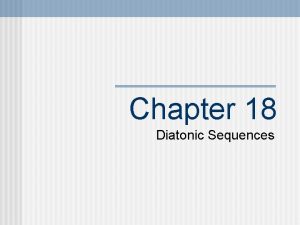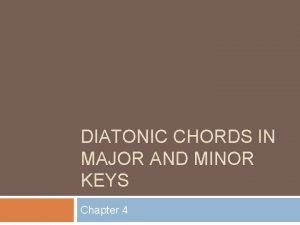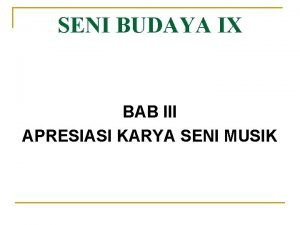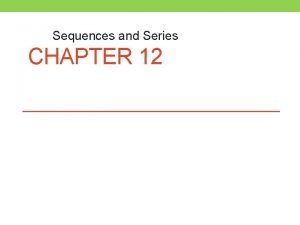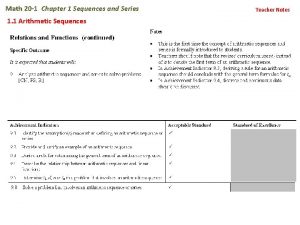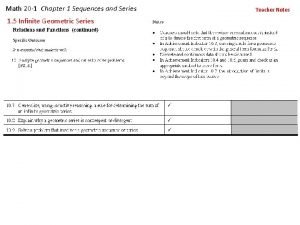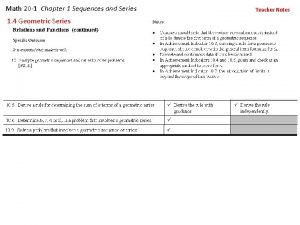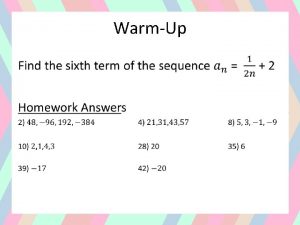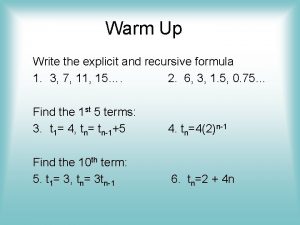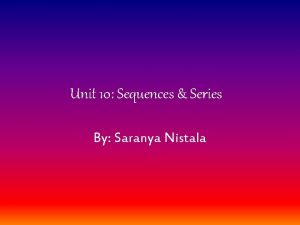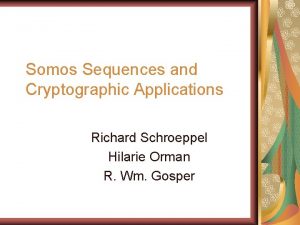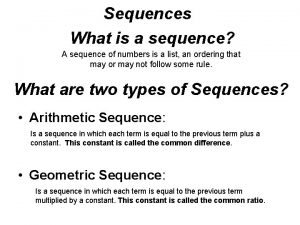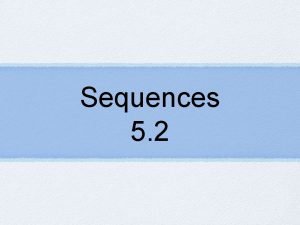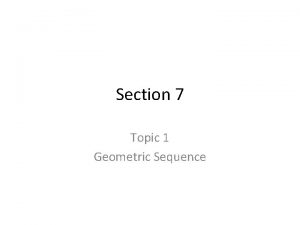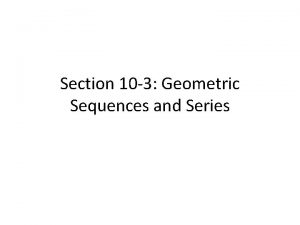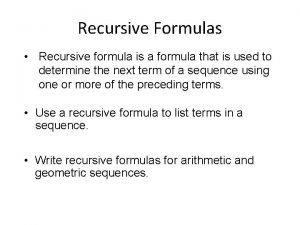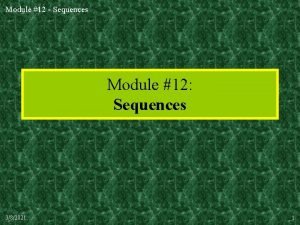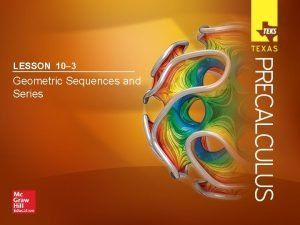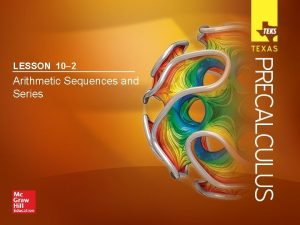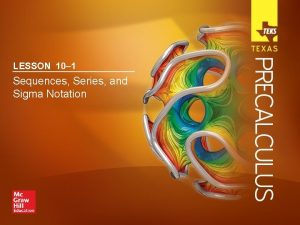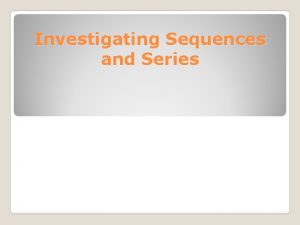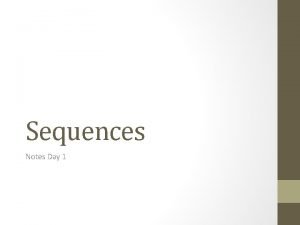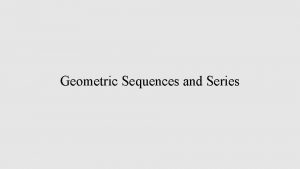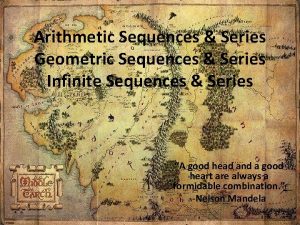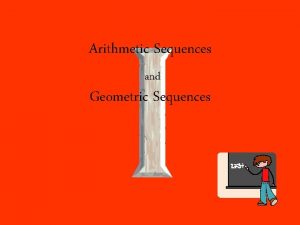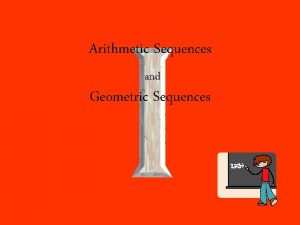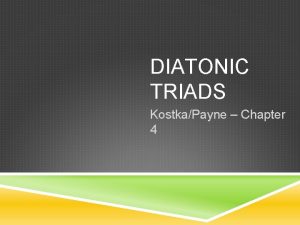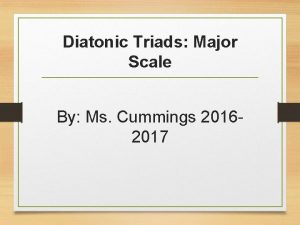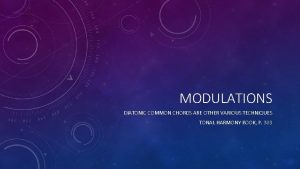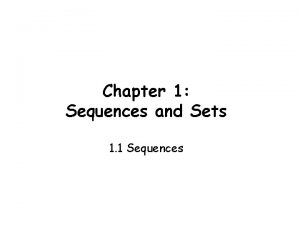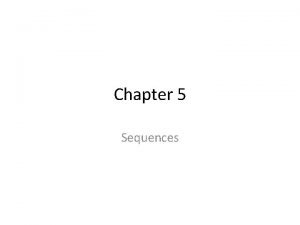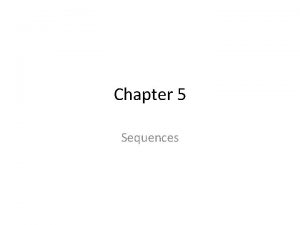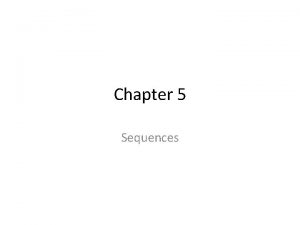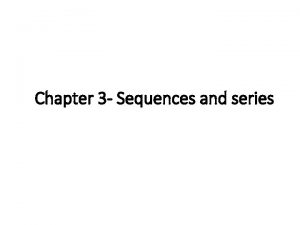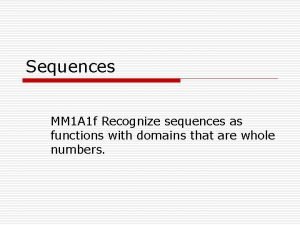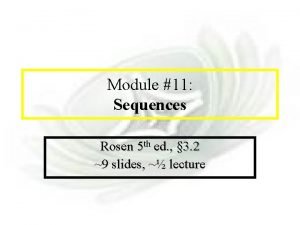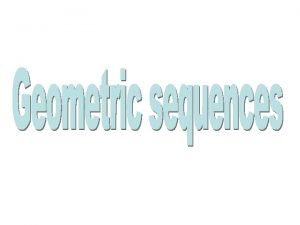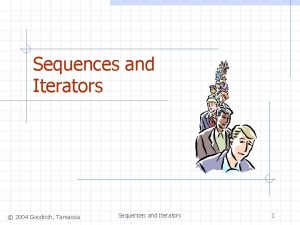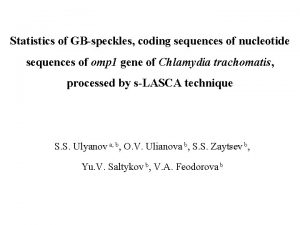Chapter 18 Diatonic Sequences In Chapter 18 You



























- Slides: 27

Chapter 18 Diatonic Sequences

In Chapter 18 You Will Learn… n n n …sequences. n Sequences in a musical context n Types of sequences …harmonic sequences based on root progressions. n Falling-fifth sequences (with 7 th chords and in popular music) n Ascending-fifth sequences n Falling-third sequences (With alternating root movements) n About sequences based on seconds (Parallel 63 chords and 7 -6 & 5 -6 motion) …reducing elaborated sequences.

Key Concept - page 325 In its most basic sense, the term sequence refers to a music pattern that is restated immediately in the same voice at different pitch level. Sequence Types - Melodic Sequence (restatements on the motive at a different pitch level, down or up) and Harmonic Sequence (the entire harmonic or contrapuntal framework is part of the sequential pattern).

Sequence Examples

Sequence Examples

Sequence Examples

Key Concept - page 326 In diatonic sequences, generic melodic intervals stay the same when the pattern moves to another pitch level, but pitch-interval qualities (for example, major to minor, or perfect to diminished). Diatonic sequences have pitches that belong to the same collection - no accidentals (unless in minor - leading tone). Chromatic sequences would have to use accidentals.

Harmonic Sequences Very similar to the root-progression we learned in chapter 16. n Usually based on root-progression. n Falling-Fifth using 7 ths chords n Ascending-Fifth n Falling-Third Sequence n Sequences based on Seconds n 7 -6 and 5 -6 Motion n

Key Concept - page 328 The falling-fifth root progression is by far the most common source of harmonic sequences; it is well suited to repetitive patterns both in the outer-voice framework and in the entire musical texture.

Falling-Fifth Root-Progression Sequences with Inversions

Key-Concept - page 330 In falling-fifth sequences, a pair of chords connected by falling-fifth root motion usually constitutes the repeated “pattern”. These pairings may link the first two chords of the chain, or the second and third (as bracketed in Example 18. 3 a). The second chord of the pattern then connects to the first chord of the next pattern by a falling-fifth root motion as well. LIP = Linear Intervallic Pattern

Key Concept - page 334 When you write falling-fifth sequences: n Follow the same part-writing guidelines as for any two chords with roots related by fifth. n In most cases, the two-chord patterns will include one voice part with a common tone. Keep the common tone, and move the other voices to the closest chord member. n If the sequence alternates first-inversion triads, the two-chord patterns may or may not have these common tone connections, depending on what you have doubled.

Key Concept - page 334 n Follow the same part-writing guidelines as for any two chords with roots related by fifth.

Key Concept - page 334 n In most cases, the two-chord patterns will include one voice part with a common tone. Keep the common tone, and move the other voices to the closest chord member.

Key Concept - page 334 n If the sequence alternates first-inversion triads, the two-chord patterns may or may not have these common tone connections, depending on what you have doubled.

Root-Progression Sequences with Seventh Chords n Same as all other sequences, but with 7 ths some or all chords.

Root-Progression Sequences with Seventh Chords in Inversions

Key Concept - page 335 In common practice style: n When you write a falling-fifth sequence with all root position seventh chords (Example 18. 9 a), parallel fifths and octaves can easily result. To avoid them, alternate complete and incomplete seventh chords (omit the fifth). Remember to resolve all of the chordal sevenths down, according to their tendency. In this case, the leading tones need not resolve up, but may be pulled down by a descending voice-leading tone. n When you write a falling-fifth sequence with alternating triads and seventh chords (Example 18. 9 b, c), every chord should be complete, with standard doubling. n Seventh-chord sequences may alternate between two inversions (Example 18. 9 d). Inverted seventh chords are usually complete in four-part settings.

Key Concept - page 335 n When you write a falling-fifth sequence with all root position seventh chords (Example 18. 9 a), parallel fifths and octaves can easily result. To avoid them, alternate complete and incomplete seventh chords (omit the fifth). Remember to resolve all of the chordal sevenths down, according to their tendency. In this case, the leading tones need not resolve up, but may be pulled down by a descending voice-leading tone.

Key Concept - page 335 n When you write a fallingfifth sequence with alternating triads and seventh chords (Example 18. 9 b, c), every chord should be complete, with standard doubling.

Key Concept - page 335 n Seventh-chord sequences may alternate between two inversions (Example 18. 9 d). Inverted seventh chords are usually complete in four-part settings.

Ascending-Fifth Sequence n n Based on the root - not the bass pitches Usually considered a harmonic sequence

Falling-Third Sequences n The descending thirds sequence gets its nickname from the way that the established pattern is moved down a third for each repetition. In its most typical appearance, you will notice that the descending thirds sequence involves a stepwise bass line, and this bass line is harmonized with alternating root-position and firstinversion chords. (Because of this pattern of inversions, the sequence is also commonly known as the descending 5 -6 sequence. )

Sequences Based on Seconds Root progressions of a second will yield parallel fifths and octaves. One intervallic arrangement that can resolve this problem is Falling-seconds sequence of chords in first inversion. This can be done in descending or ascending series of chords. This arrangement of voice leading was not addressed in the previous chapter, chapter 16, because a span of chords in first inversion is used to expand a tonic, predominant, or a dominant area. A prominent feature of the series of first inversion chords is that they contain a intervallic pattern that demonstrates a connection between the soprano-bass voice leading.

Sequences Based on Seconds: 7 6 Motion In addition to parallel first inversion chords, there are two more ways to break up the perfect intervals from appearing within the Fallingsecond sequence. First, is to feature a chain of 7 -6 suspensions.

Sequences Based on Seconds: 5 6 Motion Another sequence framework based on root motion by second is a series of root-position triads moving up by step, then delay arrival of the sixth above the bass one half beat. This will create a linear intervallic pattern of a 5 th moving to a sixth on the offbeat, thus preventing from producing parallel fifths because the voices do not move together.

Summary - page 348 When you come across a sequence in a piece of music, a contextual analysis beneath your Roman numerals will help clarify the harmonic function and goal of the passage. You may substitute for beat-by-beat Roman numerals a label on the beginning and ending chord, plus a label that describes the sequence type from among the following: n n n falling fifth (root position or root alternating with inversions, possibly with sevenths) ascending fifth (root position or root alternating with 63) falling third (stepwise bass or alternating root movements) parallel 63 chords (roots moving by seconds) 7 -6 motion (roots descending by seconds) 5 -6 motion (roots ascending by seconds)
 Descending 3rds sequence
Descending 3rds sequence Chapter 4 diatonic chords in major and minor keys
Chapter 4 diatonic chords in major and minor keys Anatoly lyadov
Anatoly lyadov Partitur lagu malayan moon bernada dasar
Partitur lagu malayan moon bernada dasar Chapter 12 sequences and series answers
Chapter 12 sequences and series answers Chapter 1 sequences and series
Chapter 1 sequences and series Chapter 1 sequences and series
Chapter 1 sequences and series Sequences and series math 20-1
Sequences and series math 20-1 Do you love the rain
Do you love the rain Good health is a choice agree or disagree
Good health is a choice agree or disagree If you think you can you can poem
If you think you can you can poem Tell me what you eat and i shall tell you what you are
Tell me what you eat and i shall tell you what you are Wherever you go i will follow you
Wherever you go i will follow you 10-2 arithmetic sequences and series
10-2 arithmetic sequences and series Explicit vs recursive sequences
Explicit vs recursive sequences Unit 10 sequences and series
Unit 10 sequences and series Somos sequences
Somos sequences Recursive rule
Recursive rule Quartic sequence formula
Quartic sequence formula Write variable expressions for arithmetic sequences
Write variable expressions for arithmetic sequences Section 7 topic 1 geometric sequences answers
Section 7 topic 1 geometric sequences answers 10-3 geometric sequences and series
10-3 geometric sequences and series Molecular scissors
Molecular scissors Recursive rule
Recursive rule Module 12 sequences and series answers
Module 12 sequences and series answers Recursive formula for geometric sequence
Recursive formula for geometric sequence 10-2 practice arithmetic sequences and series
10-2 practice arithmetic sequences and series 10-1 sequences series and sigma notation
10-1 sequences series and sigma notation
